
Doboj is a city in Republika Srpska, Bosnia and Herzegovina. It is situated on the banks of the Bosna river, in the northern region of Republika Srpska. As of 2013, it has a population of 71,441 inhabitants.

Rogatica is a town and municipality in Republika Srpska, Bosnia and Herzegovina. As of 2013, it has a population of 10,723 inhabitants, while the town of Rogatica has a population of 6,855 inhabitants.

Vareš is a town and municipality located in Zenica-Doboj Canton of the Federation of Bosnia and Herzegovina, an entity of Bosnia and Herzegovina. It is situated in central Bosnia and Herzegovina, and is famous for the local mining activities and production of iron. As of 2013, it has a population of 8,892 inhabitants, with 2,917 in the town itself.
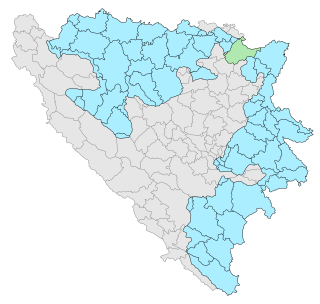
Under the "Law on Territorial Organization and Local Self-Government" adopted in 1994, Republika Srpska was divided into 80 municipalities. After the conclusion of the Dayton Peace Agreement, the law was amended in 1996 to reflect the changes to the entity's borders and now provides for the division of Republika Srpska into 64 municipalities.
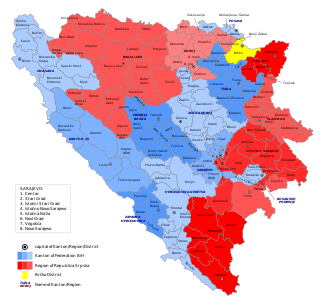
In Bosnia and Herzegovina, the smallest administrative unit is the municipality. Prior to the 1992–95 Bosnian War there were 109 municipalities in what was then Socialist Republic of Bosnia and Herzegovina. Ten of these formed the area of the capital Sarajevo.

Ljubinje is a town and municipality in Republika Srpska, Bosnia and Herzegovina. It is situated in southeastern part of Herzegovina. As of 2013, the town has a population of 2,744 inhabitants, while the municipality has 3,511 inhabitants.
Nenad Marković is a Bosnian former professional basketball player and current head coach for Dinamo Sassari in the Italian Lega Basket Serie A (LBA).
The Bosnia and Herzegovina men's national basketball team represents Bosnia and Herzegovina in international basketball competitions, and is governed by the Basketball Federation of Bosnia and Herzegovina. Until 1992, Bosnian basketballers played for Yugoslavia.
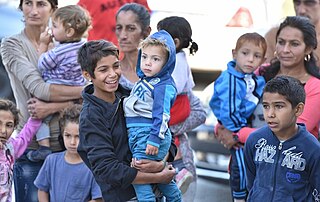
The Xoraxane in Bosnia and Herzegovina are the largest of the 17 national minorities in the country, although—due to the stigma attached to the label—this is often not reflected in statistics and censuses.

Vranduk is a historic village in the municipality of Zenica, Bosnia and Herzegovina.
Duhri is a village in the municipality of Kiseljak, Bosnia and Herzegovina.
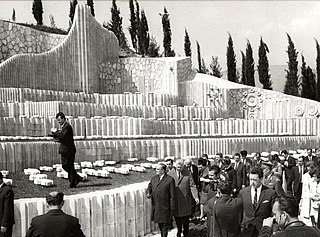
The Partisan Memorial Cemetery in Mostar is located in Mostar, Bosnia and Herzegovina. It was built in 1965 in honor of the Yugoslav Partisans of Mostar who were killed during World War II in Yugoslavia. It's located on Bijeli Brijeg and displays all the features of a complex architectural, aesthetic and landscape design. It is a unique monument in the urban scale of the city of Mostar, and is of particular ambient value.
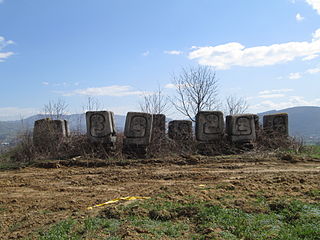
The Necropolis for the victims of Fascism, also known as Spomen obilježje na Smrekama, is war memorial located in Novi Travnik, Bosnia and Herzegovina. It was opened in 1975 to commemorate around 700 victims executed at this site during the Second World War, and designed by the architect Bogdan Bogdanović. The monument is located in farmland on a hilltop named Čamića Brdo, just off the main road between Vitez and Travnik. The site was inscribed as a National Monument of Bosnia and Herzegovina in 2012 in the Cultural Landscape category.

Central Bosnia is a central subregion of Bosnia, which consists of a core mountainous area with several basins, valleys and mountains. It is bordered by Bosnian Krajina to the northwest, Tropolje to the west, Herzegovina to the south, Sarajevo to the east and Tuzla to the northeast. It is a part of the Federation of Bosnia and Herzegovina and is divided between the Central Bosnia Canton and the Zenica-Doboj Canton, with a population of around 800,000. The largest city in the region is Zenica, with the Sarajevo-Zenica basin being the most densely populated area. Its highest peaks are Vranica, Šćit and Bitovnja.

UDIK, the Association for Social Research and Communications, is the Bosnian non-governmental organization with offices in Sarajevo and Brčko. It was founded in 2013 by Edvin Kanka Ćudić. Organization aimed to gather facts, documents, and data on genocide, war crimes, and human rights violations in Bosnia and Herzegovina and the former Yugoslavia.

The Villa Luburić or Vila Folkert or Colonel Luburić's Centre was the seat of Ustaše headquarters in 1945 Sarajevo, Independent State of Croatia. The address of this villa was Skenderija street number 49, owned by Milan Sarić. From February–May 1945, the Ustaše killed at least 323 people in this villa.

The Kazani pit killings were the mass murder of predominantly ethnic Serbs living inside besieged Sarajevo by the forces of Mušan Topalović, commander of the 10th Mountain Brigade in the Army of the Republic of Bosnia and Herzegovina during the Bosnian War.
Zulfikar Pasha Čengić nicknamed Miljevina was an Ottoman Bosnian nobleman and a military leader. He is known for leading a penal expedition against the Montenegrin Drobnjaci tribe in 1812 and siding with the Sultan against the rebellious Bosnian ayans of Husein Gradaščević during the Bosnian uprising (1831–1832).














